how to get hot chocolate stains out of clothes: Quick Guide
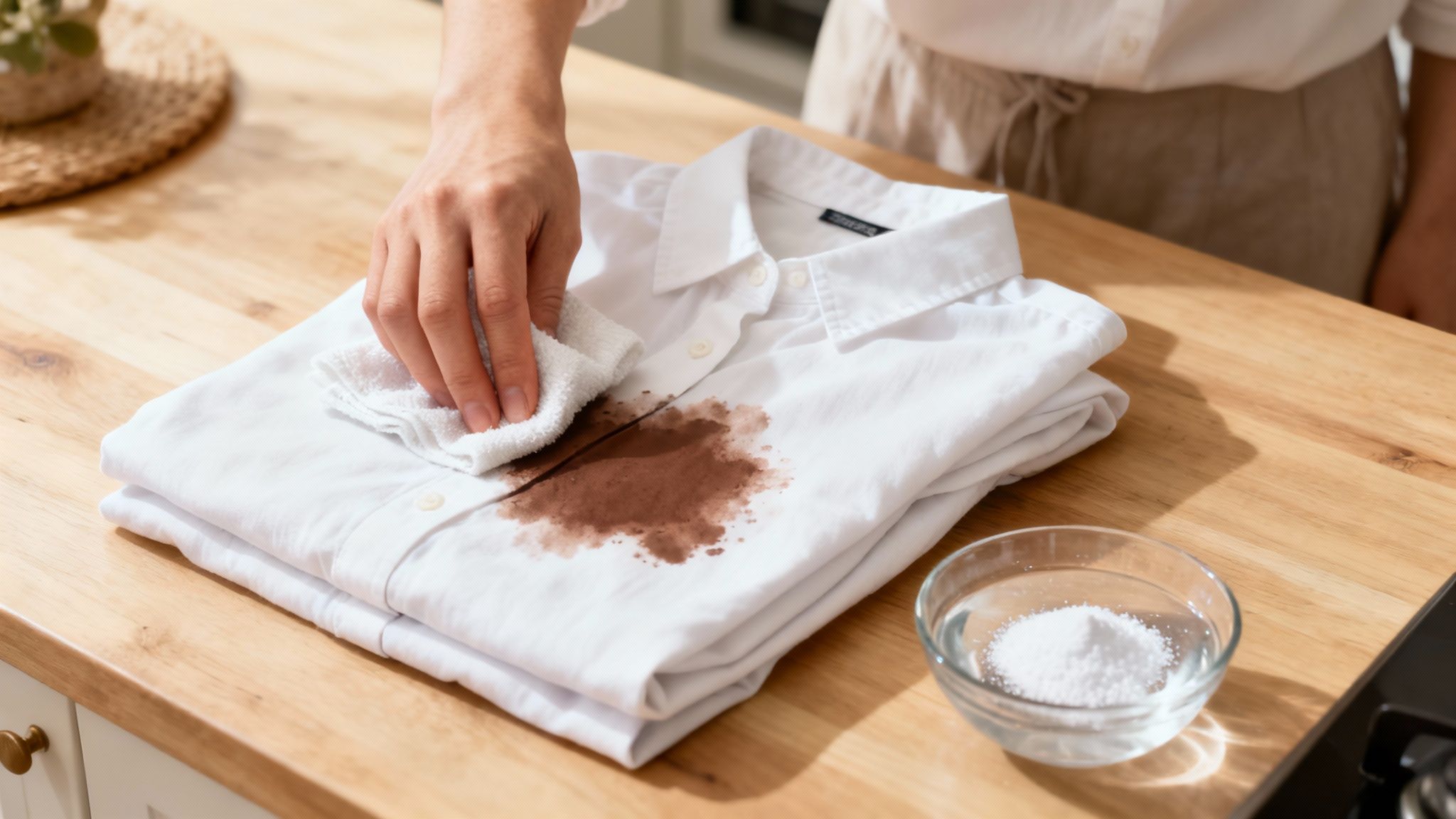
When hot chocolate spills, your first instinct might be to grab a napkin and dab. But to really save your clothes, you need a better plan. The most important thing is to act fast—scrape off any globs of chocolate, then immediately get the back of the stain under a stream of cold water. Pre-treating it with an enzyme-based detergent or stain remover before it hits the wash is your next move.
Whatever you do, avoid using hot water. It’s the number one mistake people make. The heat will actually cook the proteins and set the tannins from the cocoa, basically locking the stain into the fabric for good.
Why Hot Chocolate Stains Are So Stubborn
That cozy cup of hot cocoa seems completely harmless, right? That is, until it splashes all over your favorite white sweater. All of a sudden, you're not just dealing with a simple spill; you've got a complex combination stain on your hands.
A hot chocolate stain isn't like a simple grass or ink mark. It’s a multi-layered problem, with a few different components that all misbehave in their own unique way once they hit fabric fibers. Understanding what you're really up against is the key to getting it out. A regular wash cycle just won't cut it because each part of the stain needs a different approach.
Here’s a breakdown of what makes that brown splotch so tricky:
- Tannins: These are the natural pigments in cocoa powder that give it that rich brown color. They’re the same culprits you’ll find in notorious stain-makers like tea and red wine.
- Proteins & Fats: All the creamy goodness from the milk or cream adds a greasy, protein-based layer to the stain. Heat is the absolute enemy here, as it can permanently cook the protein right into the fabric.
- Sugars: The sugar doesn't just make it taste good; it makes the stain sticky. That stickiness acts like a magnet for dirt, making it even harder to lift everything out.
To tackle a stain this complex, you need to know what you're fighting. This table breaks it down.
Hot Chocolate Stain Components and Treatment
As you can see, each part of the stain needs a specific type of treatment, which is why a multi-pronged attack is the only way to win.
The real challenge with a hot chocolate spill is its composition. It combines cocoa solids, dairy proteins, and fats, which all set into fabric fibers when exposed to heat. This complexity is why quick action is so important.
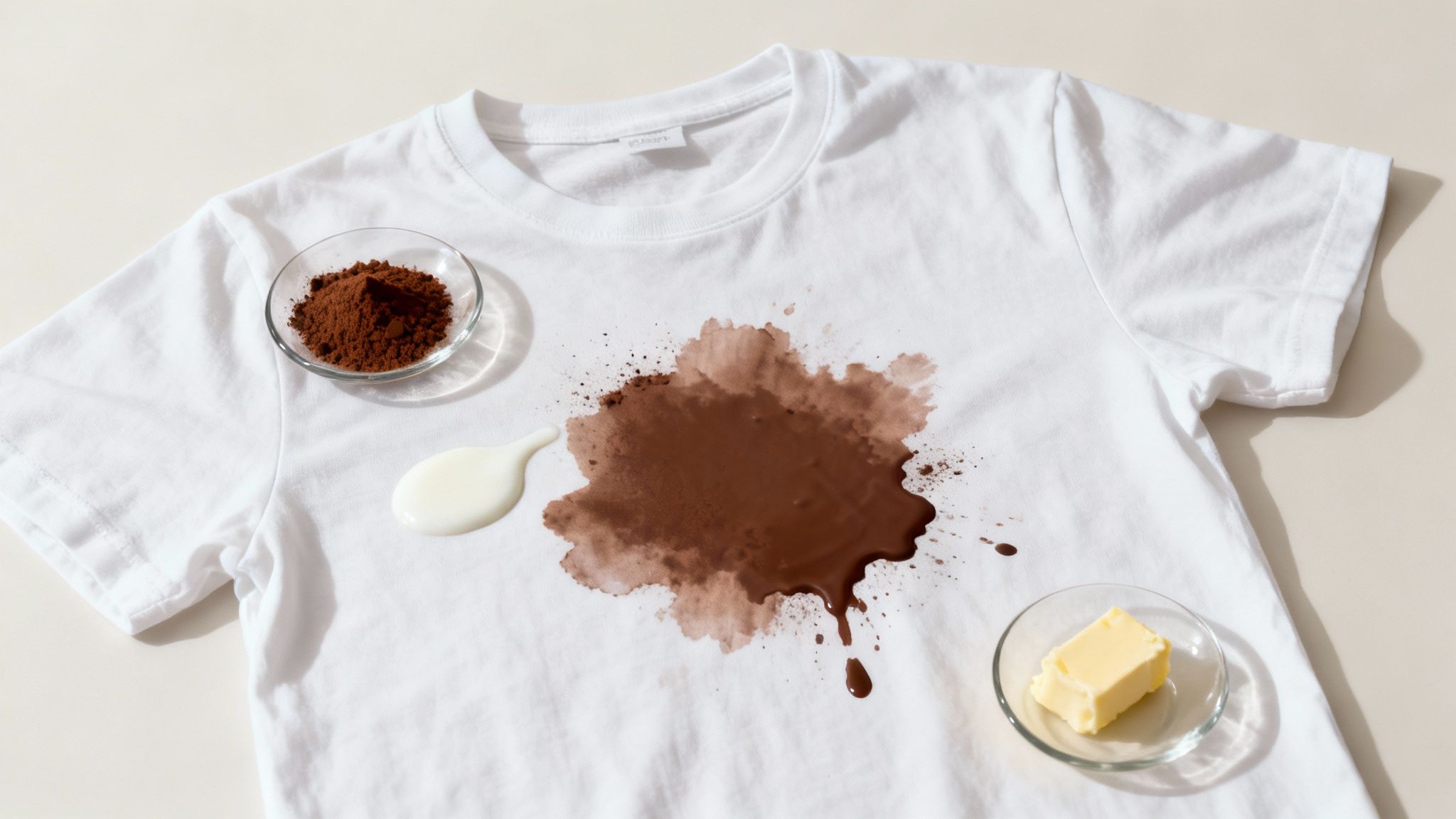
The data from our industry backs this up. Acting fast with a cool water soak and an enzyme-based cleaner gives you an 85% success rate. But if you let that stain sit and dry, the success rate plummets to below 30%, no matter how many times you wash it.
You can learn more about how different stain removers work on specific stain types in our detailed guide.
Immediate Steps for a Fresh Hot Chocolate Spill
That sinking feeling when a mug of hot chocolate tips over is all too familiar. When it makes an unwelcome appearance on your clothes, the first few moments are your best chance to get ahead of the stain. Your immediate goal is all about damage control—preventing that chocolatey mess from spreading and setting deep into the fabric fibers.
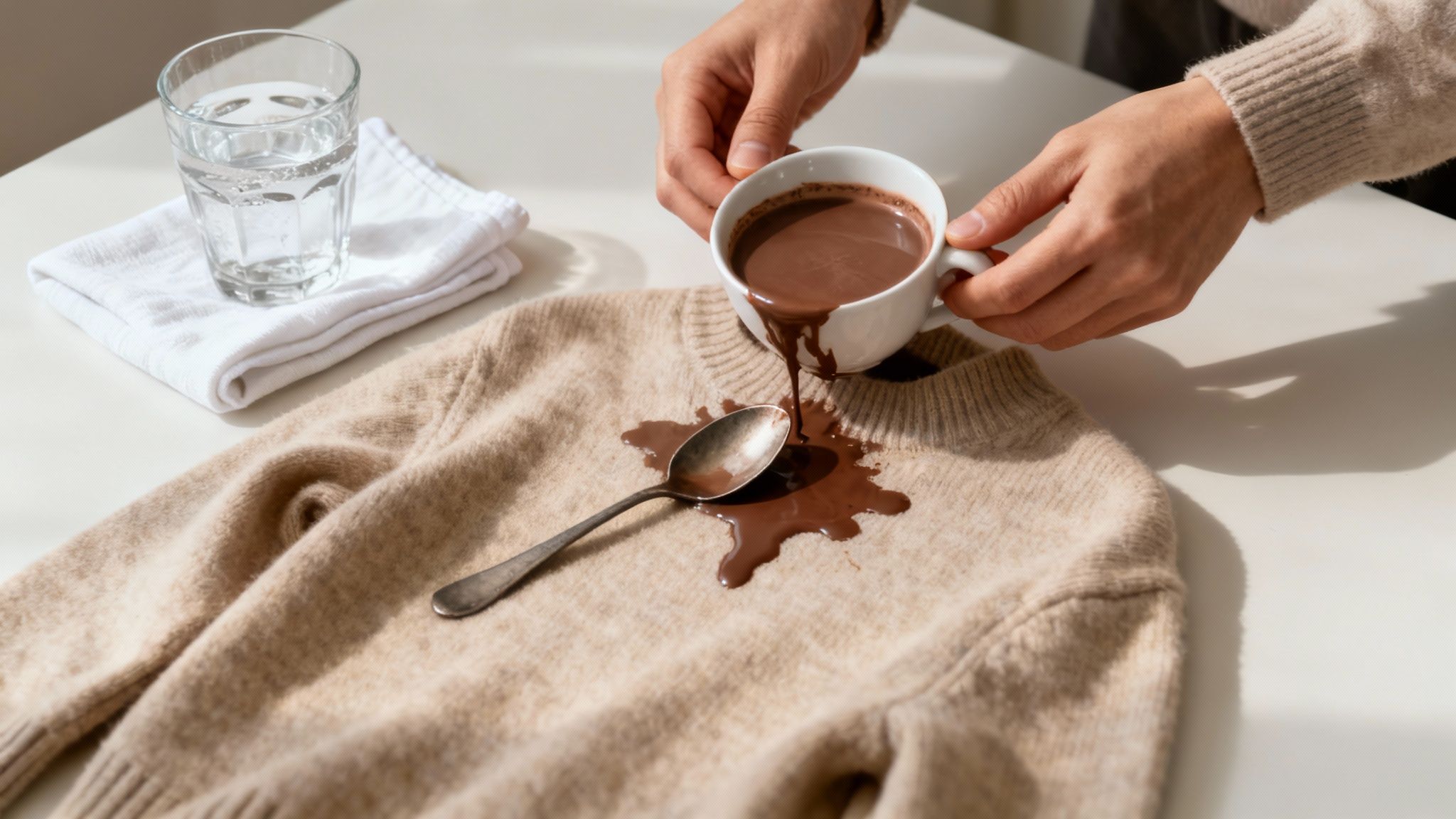
First things first, resist the powerful urge to grab a napkin and start rubbing. All that does is mash the stain deeper into the weave. Instead, grab something with a dull edge, like a spoon or even a credit card, and gently scrape off any excess liquid or thick globs. The less chocolate you have to deal with, the easier the rest of the process will be.
Flush It Out With Cold Water
Once you've cleared away the surface-level spill, make a beeline for the nearest sink. Turn the garment inside out and hold the stained spot right under a stream of cold running water. Flushing from the back is a pro tip—it pushes the stain out of the fabric instead of forcing it further through.
Whatever you do, don't use hot water at this stage. The heat will essentially cook the proteins from the milk and set the tannins from the cocoa, making the stain a permanent, unwelcome part of your shirt. This is probably the single biggest mistake people make, and it can make a hot chocolate stain almost impossible to remove later on.
Blot Gently, Don't Rub
After a good, thorough rinse, lay the damp garment flat on a clean, dry towel. Grab another clean cloth or some paper towels and gently blot the stained area. Your goal here is to lift and absorb as much of the remaining moisture and pigment as you can.
The golden rule here is simple: blot, don't rub. Blotting pulls the stain particles up and away from the fibers. Rubbing just grinds them deeper into the fabric, causing the stain to spread and lock itself in.
At this point, you've successfully managed the immediate crisis. The garment is now prepped and ready for a more targeted pre-treatment, which will break down what's left of the stain before it goes into the wash.
How to Pre-Treat Stains for Complete Removal
Once you've blotted away the initial spill, the real work begins. This next step, pre-treating, is your best shot at breaking down the stain's stubborn compounds—the fats, proteins, and tannins—before the garment even gets near a washing machine. Just tossing it in the wash and crossing your fingers is a surefire way to get a permanently stained shirt.
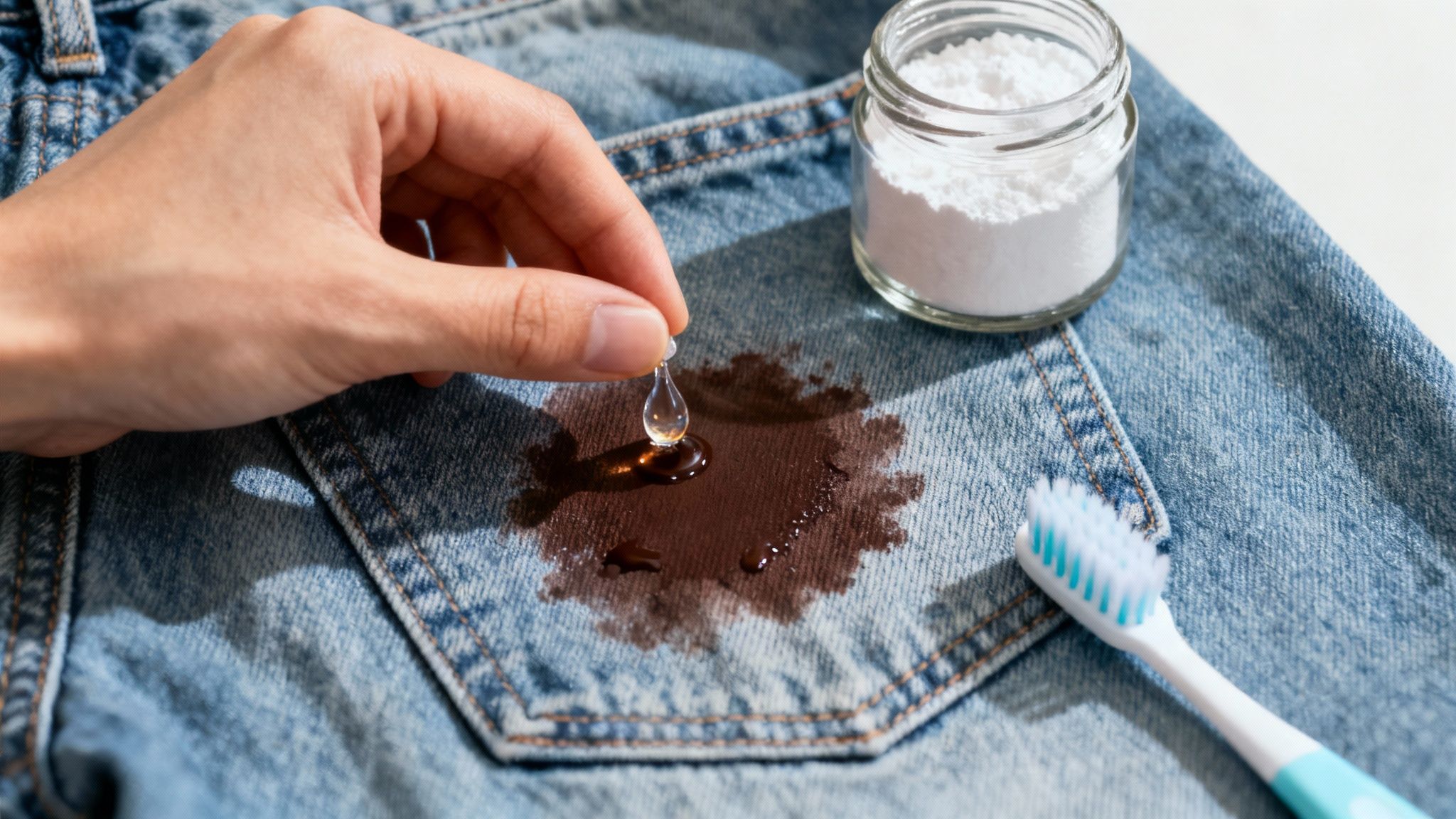
For most fresh spills, a little bit of liquid laundry detergent or even a clear dish soap can work miracles. Gently work a dab of it directly into the stained area with your fingers. Then, walk away. Let it sit for at least five to ten minutes so it has time to really penetrate the fibers and start dissolving those oils.
Choosing Your Pre-Treatment Method
The right approach really hinges on the stain's age and the fabric's durability. While a quick detergent application is usually enough for fresh spills, older, set-in stains are going to require a bit more muscle.
Here are a few reliable options you can turn to:
- Liquid Detergent: This is your go-to for most fresh stains on sturdy fabrics like cotton or polyester. Its surfactants are specifically designed to lift greasy components right out of the fabric.
- Baking Soda Paste: Got a tougher or stickier stain? Mix a little baking soda with water to create a paste. Spread it over the stain, let it sit for 15-20 minutes, and then rinse it off before washing.
- Enzyme-Based Stain Remover: This is the secret weapon for older, dried-on stains. The enzymes are formulated to break down the specific proteins and fats found in milk and chocolate, making them much easier to wash away.
The magic of enzyme cleaners is all in the science. They essentially act like microscopic scissors, chopping up the complex protein and fat molecules that make up the stain. This allows the water and detergent to flush them away effortlessly.
Why Enzymes Are a Game-Changer for Chocolate Stains
It's no surprise that enzyme-based detergents are so effective; they now make up over 70% of the US and European markets for this very reason. But here’s a shocker: a 2021 survey showed that only 35% of people knew that hot water could permanently set a chocolate stain. That reveals a major gap in laundry knowledge!
Of course, before you tackle any liquid stain, you have to deal with the solids. For messes with loose particles, using a handheld vacuum for initial cleaning can be a really helpful first move. And if you're looking for more advice on different types of spots, our pocket guide to vanishing different stains on clothes has you covered.
No matter which method you pick, the most important thing is to give the treatment time to work its magic before you wash.
The Right Way to Wash and Dry Stained Clothes
Okay, you’ve successfully pre-treated the stain. Nice work. Now, it's time for the final step: the wash cycle. It’s tempting to just toss the garment into a regular load, but a couple of specific tweaks here will make sure every last trace of that hot chocolate is gone for good.
First things first, let's talk water temperature. Hot chocolate contains milk, which is a protein. That means you absolutely must use cold water. Hot water will essentially "cook" the protein, permanently setting any faint discoloration left into the fabric. You don't want that.
Next, grab a high-quality, heavy-duty laundry detergent. I recommend one with enzymes, as they’re specifically designed to break down any stubborn protein and fat particles your pre-treatment might have missed. Run the item on a normal cycle, preferably with other similarly colored clothes just to be safe.
The All-Important Final Inspection
Before you even think about reaching for the dryer, this next part is the most critical step of all. Once the wash cycle finishes, pull the garment out and inspect it carefully under good, bright light. Look at the area from every angle. Do you see any hint of a brown or yellowish shadow?
If there's even a whisper of a stain left, do not put it in the dryer.
The intense heat from a machine dryer is a stain’s best friend. It will bake any remaining residue into the fibers, making that stain a permanent part of the garment.
Instead, if you see any lingering discoloration, simply repeat the pre-treatment steps on the damp fabric and run it through the wash again. Your safest bet is to air-dry the garment. Lay it flat or hang it up. Once it's completely dry, you can finally relax, confident that the stain is gone forever.
Removing Stains from Delicate and Tricky Fabrics
What works on a cotton hoodie can be a total disaster for your favorite silk shirt or wool sweater. Hot chocolate stains on delicate fabrics demand a much gentler, more careful approach. These materials just can't take aggressive scrubbing or the harsh chemicals found in many standard stain removers.
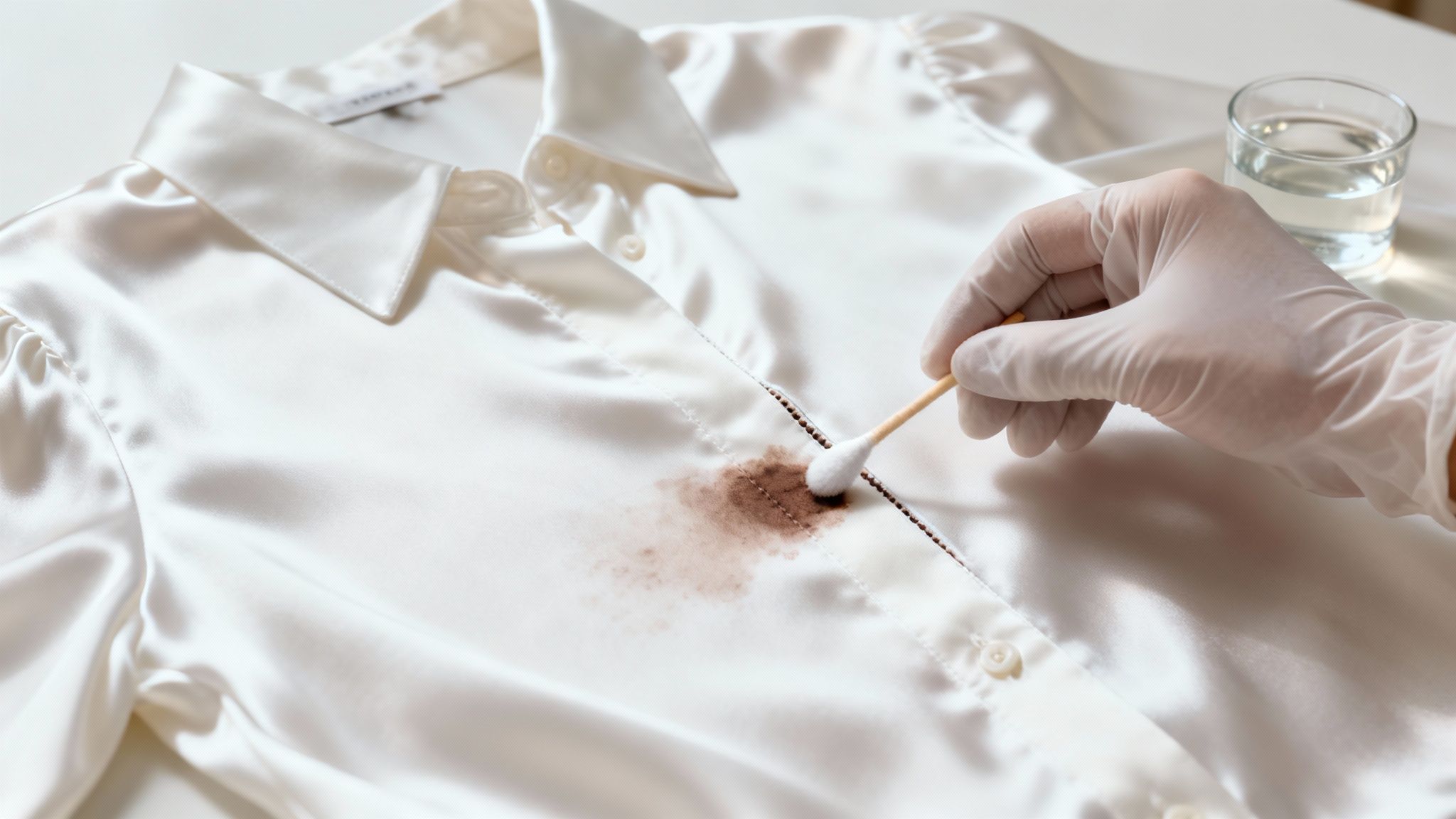
When you're dealing with wool, silk, or anything similar, always start with the basics. First, gently scrape off any excess chocolate. Then, turn the garment inside out and flush the back of the stain with cold water.
Next, you’ll want to mix up a very mild cleaning solution. A teaspoon of a pH-neutral detergent—like one made for woolens—dissolved in a cup of cool water is perfect. Gently dab this solution onto the stain using a clean, white cloth.
Always, always do a spot test on a hidden area first, like an inside seam. This quick check saves you from the heartbreak of finding out your cleaning solution has discolored or damaged your garment.
Handling Specific Fabric Challenges
Different fabrics react in very different ways. For example, wool is extremely sensitive to the enzymes in many common detergents, which can actually break down its fibers over time. Silk, on the other hand, needs extra care to avoid leaving water spots and dulling its natural shine.
Many of the gentle principles for stain removal apply across delicate fabrics. For more detailed advice, our guide on how to get oil stains out of silk has some great tips that are also useful here.
For a stubborn stain on a white, non-delicate item, a careful application of diluted hydrogen peroxide can sometimes work wonders on the tannin part of the stain. But be warned: this is a more advanced technique that comes with the risk of lightening the fabric, so proceed with caution.
Stain Removal Agent Safety by Fabric Type
To help you navigate these tricky situations, here’s a quick reference guide for which common cleaning agents are safe for different fabrics.
Think of this table as your cheat sheet. When in doubt, a quick check here can prevent a costly mistake and keep your favorite clothes looking their best.
Got a Stubborn Hot Chocolate Stain? Let's Talk Strategy.
Even when you know the basic steps for tackling a hot chocolate spill, some situations are just trickier than others. Life happens, right? You might not notice a drip until it's long since dried, or you might be tempted to reach for the strongest cleaner under the sink. Let's break down a couple of the most common questions that pop up.
Can I Get an Old, Dried Hot Chocolate Stain Out?
The short answer is yes, but you’ll need a bit more patience than you would for a fresh spill. When a hot chocolate stain dries, the sugars and milk proteins have had time to really latch onto the fabric fibers, making them notoriously stubborn.
Your first move is to grab a dull knife or the edge of a spoon and gently scrape off any flaky, dried bits. Don't go wild here—the goal is just to lift off that surface-level crust without damaging the fabric underneath.
After that, it's all about the soak. A good, long soak is your best friend. Submerge the garment in cold water mixed with an enzyme-based stain remover for at least 30 minutes. For a really set-in stain, letting it sit for a few hours or even overnight can make all the difference in breaking down its grip.
Is It Safe to Use Bleach on a Hot Chocolate Stain?
This is a big one, and I'm going to give you a hard "no" on this—at least when it comes to standard chlorine bleach.
Chlorine bleach can have a chemical reaction with the milk proteins left behind by the hot chocolate. This reaction can permanently yellow the fabric or, ironically, make that brown stain even darker and more obvious. It’s a risk that’s just not worth taking.
Now, if you're dealing with a sturdy, all-white cotton item, you have another option: oxygen-based bleach (like OxiClean). It works differently, breaking down the stain's components without that harsh chemical reaction. Even so, I always recommend doing a quick spot test on a hidden area, like an inside seam, just to be absolutely sure it won’t affect the fabric.
Still wrestling with a stubborn stain or just want to skip the hassle altogether? Columbia Pike Laundry is here to help. We give busy families their lives back by handling the tough stuff for you.
Popular Blog Articles

Meet the Author
Daniel Logan didn’t start CPL because he loved laundry. He started it because his family was drowning in time debt, and laundry was one of the biggest weights.
Mornings were chaos with two kids under 5. Evenings felt like catch-up. And weekends? Gone to sorting socks and folding piles.
He knew his story wasn’t unique. So he built a business that gave families like his just a little bit of breathing room one load at a time.
With no laundry experience but deep tech skills, Daniel rolled up his sleeves, doing every job himself while building systems that turned it into a modern laundry service that saves customers time, simplifies their lives, and delivers reliability they can count on.
That’s where CPL began. Not from a playbook, but from pain. From one dad trying to buy back time: for himself, and for every household like his.





